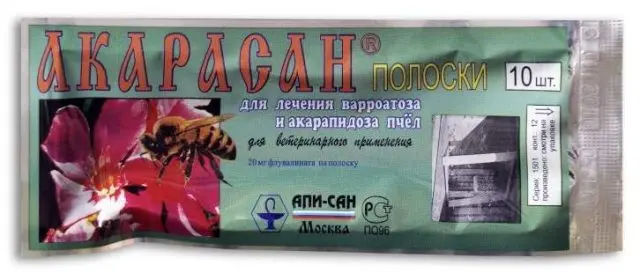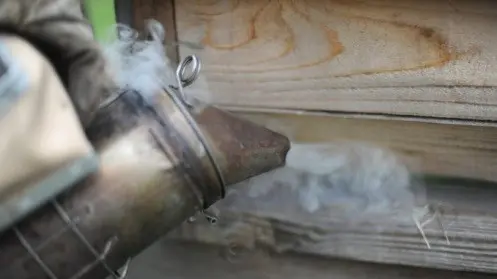Contents
Akarasan refers to specialized highly effective insecticides aimed at the destruction of mites, called acaricides. Its action has a narrow specialization and allows you to destroy varroa mites (Varroajacobsoni), as well as Acarapis woodi (Acarapiswoodi), which parasitize domestic honey bees. The article presents instructions for the use of Akarasan for bees, indicates the features of the use of the drug.

The use of the drug in beekeeping
Akarasan was created for use in domestic and industrial beekeeping for the prevention of the following diseases of bee colonies:
- acarapidosis;
- varroatosis.
Composition, form of release
The composition of the Akarasan dose includes two components:
- fluvalinate – 20 mg;
- potassium nitrate – 20 mg.
Akarasan is a means of fumigation. That is, the smoke from the combustion products of the drug has healing properties. For ease of use, Akarasan is produced in the form of strips of cardboard measuring 10 cm by 2 cm with a thickness of 1 mm.
The strips are stacked in 10 pieces in sealed foil packages with three-layer walls.
Pharmacological properties
The active substance of Akarasan – fluvalinate, which is a derivative of the racemate, is a powerful remedy against small ticks. He has proven himself in the fight against varroa and acarpis mites. The acaricidal action of fluvalinate is best manifested as an airborne suspension in the air or in the form of vapors.
When using the drug, the base of the strips is set on fire, it begins to smolder, which leads to the evaporation of fluvalinate and its air contact with the mites that are on the bees in the hive. It is enough for a bee to stay in a hive filled with fluvalinate vapors for about 20-30 minutes for the mites to receive a lethal dose of the drug.
Instructions for use of Akarasan strips
Strips of the drug are fixed on empty nest frames and set on fire, after which they are immediately extinguished, and the frames with smoldering plates are installed in the hive.
The entrances of the hives are closed and an hour later they are opened, removing the burnt strips. If the Akarasana strip has not burned out completely, the treatment is repeated after an hour. In this case, a whole strip or half of it is used.
Dosage, application rules
According to the instructions, the dosage of Akarasan is one strip for 9 or 10 cells.
It is necessary to apply the drug in such a way that the majority of bees are in the hive. In addition, at the time of processing, the bees in the hive must have water.
When bees are affected by acarapidosis, the treatment is done 6 times per season with a break of a week. The fight against varroatosis involves two treatments in the spring and two in the fall, following one after the other a week later.
Contraindications and restrictions for use
When the dosage is observed, no side effects are observed.
However, there are restrictions on the use of Akarasan, depending on various circumstances:
- Treatment with Akarasan should be carried out only at an air temperature above + 10 °C.
- Processing of the bee family should be carried out early in the morning or late in the evening.
- The procedure should not be applied earlier than 5 days before honey collection.
- It is forbidden to process small colonies and small hives (if the number of “streets” in the hive is less than three).
Akarasan belongs to substances of the fourth hazard class. For the human body, it is not toxic and does not pose a danger.
Shelf life and storage conditions
Akarasan strips are stored in a cool and dark place with a temperature of + 5 °C to + 20 °C. Shelf life under these conditions is 24 months.
Conclusion
Instructions for using Akarasan for bees are quite simple, and the effectiveness of this drug on ticks is high. If you follow the correct treatment schedule, you can be guaranteed to protect your apiary from the invasion of parasitic mites.

Reviews
Below are reviews on the use of Akarasan strips.









